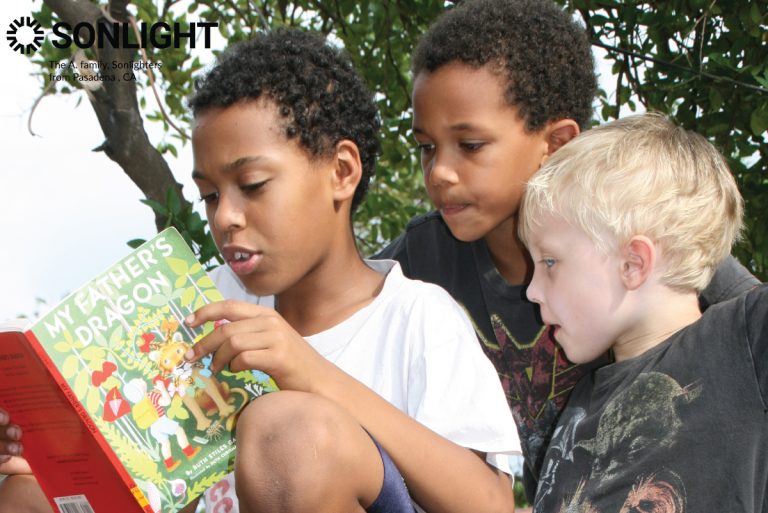
After the kids and I, one after the other, showed the dreaded symptoms of covid-19, we were fated to a month-long self-isolation. Without a co-parent, or even a walk around the block to ease the pressure, I’ve had a crash-course in homeschooling in a lockdown.
My first lesson was to get our school work done in the early afternoon , so we can play in the garden for the rest of the day. Here are three other tips for staving off the bickering when we all feel cramped as homeschoolers in quarantine.
1. Focus on Readers and Illustrated Read-Alouds
Before being cooped up, we were all enjoying being transported by A Door in the Wall to the plague-ridden 14th century, but in our present state of mind, the delicate, archaic language is a little hard to take in. I’m hitting pause on beloved Marguerite De Angeli, and focusing on shorter, illustrated books.
How is it possible to get three rowdy children of various ages interested in a French scientist’s discovery of microbes in 1800s without a generous dose of twaddle to sweeten the deal? Pasteur's Fight Against Microbes is the answer. Three squirming bottoms were no match for this biography. Pasteur’s journey from problem to experimentation to solution has earned its place as our favorite history of science book so far.
If I finish my dinner before the kids, out comes a book like Eric the Red and Leif the Lucky. I use the abacus and globe we keep on the table to discuss it. The discs on the abacus show the number of men who set out from Iceland and how many made it to North America. On the globe, we found his journey to Greenland and back. This, with the illustrations of Eric the Red, the weather-worn Scandanavian and the author’s matter-of-fact description of a breathtaking and under-appreciated journey, gave them something to chew on with their lunch.
Though she will not take in forty minutes of a chapter book, my seven-year-old is glad to read aloud a Reader like Helen Keller as she paces back and forth like a caged cat. It’s a tall order to focus on being an ambassador for Christ when she’s not even seeing any of her friends, but encouraging her family with a story like this is a reminder that service is a guiding principle for her education.
2. Use an Immersive Reading Nook
Even a socialite like my seven-year-old daughter needs privacy, sometimes contrary to her own opinion. When her less emotionally mature brothers are impossible to negotiate with, she needs a space where she can achieve without interference.
The problem is, when it comes to her daily Math-U-See workbook, she doesn’t want to retreat to a room alone. As a solution, I bought her a pair of noise-cancelling bluetooth headphones.
She sits in the writing desk we built together, facing the corner of the living room and listens to a combo of fireplace ambience overlaid with Chopin’s nocturnes. It is her zone within our collective zone. She is not alone, but even her youngest brother knows it is not permissible to distract her.
In the reading nook, she is responsible for her to-do list. One chapter of The Horse and His Boy, following along with the audiobook, two pages of the Math-U-See workbook, and finally, reading and replying to letters from friends. Having conquered her small and specific to-do list, she emerges with a sense of control that takes the panic away from her subsequent interactions. Now compromise with her little brothers can come from a slightly deepened well of calm.
3. Encourage Complaints
Handwriting and math have always elicited the fiercest complaints from my little students. It’s possible that the inflexibility of the subjects are partly to blame. Creative types want to feel like they’re trailblazing, rather than acting as containers for set techniques.
Since quarantine, however, I’ve had to confront a few complaints that I would otherwise have dismissed as a bad attitude. Instead of shushing complaints, I ask them to make a note, and bring it up during the morning meeting.
The following morning I sit down with them and this conversation ensues:
“Thank you for being honest about how boring you find handwriting at the moment. I can see how beautiful your letters are after these ten pages of handwriting. Do you think the solution is to stop handwriting altogether?”
“No, but I only want to do one page.”
“Would that be best? Maybe we can try one more week, and if it’s still frustrating you, we’ll change it next week. Every time you feel angry about it, make a note, and we can look at it together next week and decide.”
After complaints are heard and discussed, they become few and far between.
Complaints are attempts to make change, and I want to encourage that impulse. I also want my children to take on the responsibility of examining their own impulses. Let’s talk about whether the change is desirable, then let’s meet together and strategize. That process is too difficult when tempers are high, so we set a meeting time to talk calmly.
Encouraging change-makers while examining the change has helped me move from managing balls of chaos to purposeful and sensitive team-work. Sensitive team-work, I’m learning, is the only strategy for peaceful homeschooling in the coronavirus lockdown.
All-Subjects Package are based on our best recommendations after 30 years of ongoing research, development, and feedback from families around the world.








